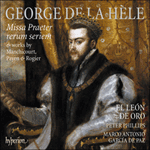The six-voice setting of
Regina caeli is based on an ingenious canon between the two upper voices. Although the pitch interval of the canon is consistently a fourth, the time difference is varied; the singers are instructed ‘sans souspirer ne chantez poinctz’ (literally, ‘do not sing at all without breathing’). The hidden meaning of this phrase is that the singer must omit all minim rests—known colloquially as ‘souspirs’ at this time—and also that all rhythms extended by a dot (‘poinct’) should be sung as if the dot were absent. Obeying these rules turns the smooth rhythm of the upper voice into an energetic, highly syncopated line, which begins two bars behind its neighbour and reaches the end of the motet’s first section two bars ahead. In the second section, the roles are reversed. Meanwhile, the four lower voices also adopt playful syncopated rhythms, as for instance the tenors at the beginning of the second part.
from notes by Stephen Rice © 2007
Le
Regina caeli à six voix repose sur un ingénieux canon entre les deux voix supérieures. Quoique l’intervalle de ce canon soit constamment d’une quarte, la différence de mesure est variée; «sans souspirer ne chantez poinctz», est-il enjoint aux chanteurs. Le sens caché de cette phrase est le suivant: l’interprète doit omettre toutes les demi-pauses—couramment appelées «soupirs» à l’époque—et tous les rythmes prolongés d’un «poinct» doivent être chantés comme si ce point n’existait pas. Suivre ces règles fait du rythme régulier de la voix supérieure une ligne énergique, des plus syncopées, qui commence deux mesures après sa voisine mais atteint la fin de la première section avec deux mesures d’avance. Dans la seconde section, les rôles sont inversés. Pendant ce temps, les quatre voix inférieures adoptent, elles aussi, d’enjoués rythmes syncopés, à l’image des ténors en début de seconde partie.
extrait des notes rédigées par Stephen Rice © 2007
Français: Hyperion Records Ltd
Die sechsstimmige Vertonung des
Regina caeli beruht auf einem genialen Kanon der zwei Oberstimmen. Obwohl das Tonintervall zwischen den beiden Stimmen streng eine Quarte bleibt, wird der Zeitunterschied variiert: die Sänger werden angewiesen, „sans souspirer ne chantez poinctz“ d.h. „ohne zu atmen, keine Punkte zu singen“. Die Bedeutung dieser Anweisung ist, alle halben Pausen—die umgangssprachlich damals „souspirs“ hießen—auszulassen und alle punktierten Noten ohne Punkt („poinct“) zu singen. Die Beachtung dieser Regel verwandelt den glatten Rhythmus der Oberstimme in eine energische, stark synkopierte Linie, die zwei Takte nach ihrer Nachbarin beginnt und das Ende des ersten Abschnitts zwei Takte vor ihr erreicht. Im zweiten Abschnitt werden die Rollen umgekehrt. Die vier Unterstimmen, wie etwa die Tenöre am Anfang des zweiten Teils, singen unterdessen ebenfalls spielerisch synkopierte Rhythmen.
aus dem Begleittext von Stephen Rice © 2007
Deutsch: Renate Wendel
Con un texto mucho más brillante, Manchicourt despliega en su
Regina caeli a seis voces uno de los recursos matemáticos más severos del manual compositivo del Renacimiento flamenco temprano, un canon. Se trata de un enfoque bien diferente del de Rogier para doble coro, que veremos más adelante, con poca escritura real y mucha vida rítmica agitada a la manera protobarroca. En la versión de Manchicourt, el canon se escucha permanentemente en las voces de soprano: en la primera mitad de la obra, la soprano I lidera y la soprano II la sigue cuatro partes más tarde a la cuarta inferior, mientras que en la segunda mitad se invierten los papeles y la soprano II comienza cinco partes antes que la soprano I, que repite la melodía a la cuarta superior.
Aunque esto suena muy académico, Manchicourt también tenía, a su manera, una faceta juguetona. Como ya hiciera Josquin antes que él, disfrutaba dándoles pequeños fastidios a los cantantes. Al añadir al inicio del manuscrito la indicación «sans souspirer ne chantez poinctz» («sin respirar, no cantéis puntillo»), exigía a la segunda voz que omitiera los silencios de blanca y eliminara el puntillo de cualquier nota con puntillo que pudiera aparecer en la voz principal de modo que, aunque la soprano II comienza el motete cuatro partes más tarde que la soprano I, termina la prima pars cinco partes antes (y en la secunda pars siete partes más tarde, al intercambiarse los papeles). En este proceso, la línea vocal ya de por sí muy melismática se vuelve inusualmente sincopada. Manchicourt replica estas características en las otras voces, con lo que crea un brillante ejemplo de lo complejo que puede ser el estilo polifónico de alguien que, sin duda, estaba un tanto anticuado en su época. Mientras todo esto sucede en las voces superiores, Manchicourt procura que gran parte del material de las inferiores se base en el canto gregoriano original Regina caeli mediante paráfrasis. Con la técnica imitativa en la que era tan experto, esta melodía gregoriana influye en todas las voces y convierte la composición en un todo notablemente orgánico.
extraído de las notas de Peter Phillips © 2024
Español: Millán González



 La Hèle: Missa Praeter rerum seriem & works by Manchicourt, Payen & Rogier
La Hèle: Missa Praeter rerum seriem & works by Manchicourt, Payen & Rogier
